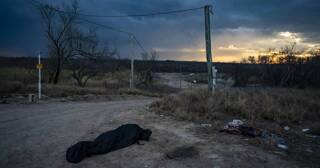TIME: Why Cold Weather Doesn’t Disprove Global Warming
One of the most ignorant (and often intentionally deceptive) “common sense” talking points promoted by the climate denial industry is that cold weather proves global warming theories are a hoax. Every time there’s a blizzard, this hoary old chestnut is taken out of the freezer, thawed out, and hyped by all the usual suspects, including the Republican Party. And every time they defrost it, it smells worse.
Here’s a good article in TIME Magazine explaining why this talking point should be (but won’t be, it’s too useful as propaganda) thrown out with that tuna casserole from 1998: Snowstorm: East Coast Blizzard Tied to Climate Change.
As the blizzard-bound residents of the mid-Atlantic region get ready to dig themselves out of the third major storm of the season, they may stop to wonder two things: Why haven’t we bothered to invest in a snow blower, and what happened to climate change? After all, it stands to reason that if the world is getting warmer — and the past decade was the hottest on record — major snowstorms should become a thing of the past, like PalmPilots and majority rule in the Senate. Certainly that’s what the Virginia state Republican Party thinks: the GOP aired an ad last weekend that attacked two Democratic members of Congress for supporting the 2009 carbon-cap-and-trade bill, using the recent storms to cast doubt on global warming.
Brace yourselves now — this may be a case of politicians twisting the facts. There is some evidence that climate change could in fact make such massive snowstorms more common, even as the world continues to warm. As the meteorologist Jeff Masters points out in his excellent blog at Weather Underground, the two major storms that hit Philadelphia, Baltimore and Washington, D.C., this winter — in December and during the first weekend of February — are already among the 10 heaviest snowfalls those cities have ever recorded. The chance of that happening in the same winter is incredibly unlikely.
But there have been hints that it was coming. The 2009 U.S. Climate Impacts Report found that large-scale cold-weather storm systems have gradually tracked to the north in the U.S. over the past 50 years. While the frequency of storms in the middle latitudes has decreased as the climate has warmed, the intensity of those storms has increased. That’s in part because of global warming — hotter air can hold more moisture, so when a storm gathers it can unleash massive amounts of snow. Colder air, by contrast, is drier; if we were in a truly vicious cold snap, like the one that occurred over much of the East Coast during parts of January, we would be unlikely to see heavy snowfall.
UPDATE at 2/10/10 3:40:26 pm:
Jeff Masters explains in more technical detail at Wunder Blog.
Heavy snow events—a contradiction to global warming theory?
As I discussed in my previous post, record-breaking snowstorms are not an indication that global warming is not occurring. In fact, we can expect there may be more heavy snowstorms in regions where it is cold enough to snow, due to the extra moisture global warming has added to the atmosphere—an extra 4% since 1970. Snow is not the same as cold, and we have to look at global temperatures, not snowfall, to evaluate whether global warming is occurring. Heavy snow can act to bring down global temperatures, as occurred in December 2009, when the Northern Hemisphere experienced its second greatest snow extent on record (only 1985 saw greater December snow cover since reliable snow records began in 1967). Global average land temperatures, as a result, were just 31st warmest on record, even though global ocean temperatures were the 2nd warmest on record. It will be interesting to see what global temperatures did in January, when the statistics are released next week. The global temperature of the lower atmosphere as measured by satellites was the warmest on record in January, and by a considerable margin. I’ll discuss this finding in more detail once the blizzard is over. It’s also of interest to note that December temperatures in the U.S. were the 18th coldest in the historical record, but January temperatures were 0.3°F above average, according to the National Climatic Data Center. As a whole, it’s been a colder than average winter in the U.S., but not greatly so. However, December snow cover was the greatest on record in the contiguous U.S., and January’s ranked sixth. Snow cover records go back 44 years, to 1967.










